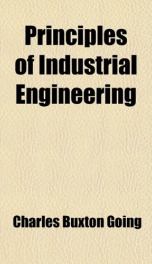principles of industrial engineering

Purchase of this book includes free trial access to www.million-books.com where you can read more than a million books for free. This is an OCR edition with typos. Excerpt from book: CHAPTER III PRINCIPLES OF INDUSTRIAL ORGANIZATION WE have seen so far that the introduction of power and machinery first inaugurated the manufacturing era, and next gave rise to certain tendencies and policies in manufacturing. The most important of these were growth in size of the manufacturing plant, and development of manufacture on a wholesale scale; and in connection with this the re-apportionment of duties among the artisans employed, so that it has become general for each to do only some limited special part of the whole process of manufacture, and to do this by repetitive reproduction of a fixed pattern. While this has vastly reduced costs of production and facilitated manufacture per se, it .is evident that from the works-management point of view it introduces very serious problems. One is merely quantitative; the great size of a modern factory makes it impossible for the manager to oversee it all in person. Another is the division of operations among different workmen or departments. Each single thing manufactured starts, or may start, in as many different places as it has parts, each part again being not an individual but one of a lot of like parts; and such a lot of identical parts, though they start off together through the shop, may later on be divided and sub-divided and diverge to various finished products if they happen to be standard to more than one pattern. The workman actually engaged on the job has no idea of the destination of his work and no responsibility beyond finishing his own individual job to the standard pattern and quality, and perhaps within'some standard time. Take a pocket knife for illustration. It has a blade of a certain size and shape, which probably is used not only in the one pattern of knife we happen to be considering, but also i...
Info about the book
Author:
Series:
Unknown
ISBN:
1439857490
Rating:
3.5/5 (4)Your rating:
0/5
Languge:
English
Users who have this book
Users who want this book
What readers are saying
What do you think? Write your own comment on this book!
write a commentGenre
if you like principles of industrial engineering try:
Other books by this author
Do you want to read a book that interests you? It’s EASY!
Create an account and send a request for reading to other users on the Webpage of the book!


